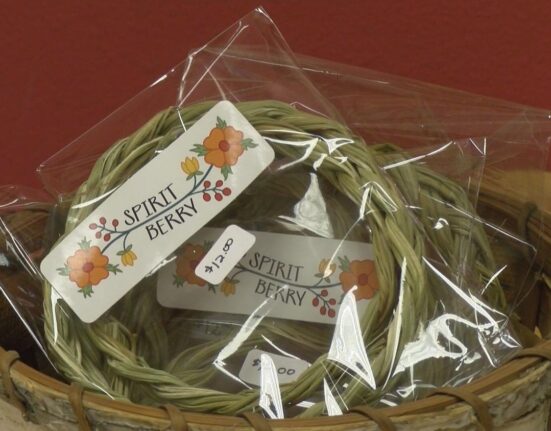Google “The Most Famous Artist,” and one of the first links that comes up is for a guy named Matty Mo. His work is designed to grab attention online — he’s best known for turning the “Hollywood” sign into one that said “Hollyweed,” and says his preferred medium is “tomfoolery.”
But after years of flashy projects that were all about the internet, Mo wants to get loud about things like climate change.
“Resilience, sustainability and self sufficiency — those are the topics that I think matter as we face future challenges,” Mo said.
So he reached out to another artist, Ajax Axe, who runs an organization called Kairos Futura in Aspen and Nairobi, Kenya. It’s an artist collective that collaborates with scientists and activists on projects related to climate change, on the premise that creative messaging and buzzworthy events can help more people think about their impact on the environment and engage with the world around them. (The initiative started as an “Aspen Space Station” installation a few years ago with a catchy slogan: “Earth is sexier than Mars.”)
Then, Axe invited Mo to a “Burn Lab” program earlier this year that started with a long day of manual labor on Basalt Mountain in the scar of the Lake Christine wildfire. More than half a dozen artists were part of a volunteer group to help the White River National Forest with a soil restoration project in a sliver of the 12,000 acres that burned back in 2018.

Kaya Williams
/
Aspen Public Radio
Axe said artists are good communicators, “and we’re capable of making issues that might be difficult to understand easy and visually appealing for people.”
“And so my goal is to help the scientists who are doing really important work to get more funding to be able to expand these wildfire ecosystem restoration projects,” she added.
Funding isn’t the only challenge, though. You also need manpower, according to U.S. Forest Service soil scientist Ryan Sparhawk.
“I’m a single resource for the forest and the only soil scientist on site,” he said. “I have a lot of work to do across the White River, and my time is limited, but when a group can come together to help me with this, it’s a big opportunity for me to try something new.”
The hard work started with shovels, as Axe and Mo helped Sparhawk dig a soil pit to gain a better sense of how the land irecovering from the fire.
“We’ve got burnt roots, there’s no soil structure in this, the organic matter is all burnt off,” Sparhawk said. “This is the result of a … high soil burn severity fire.”
And where there used to be a lot of different vegetation, now it’s mostly plumeless thistle, a prickly, invasive plant that isn’t great for wildlife habitat, cattle grazing or biodiversity.

Kaya Willaims
/
Aspen Public Radio
The Forest Service could spray the land with herbicide — that would get rid of the thistle — but since they have some help from Kairos Futura, the crew gets to try something different, to see if they can restore the soil health with a mix of organisms like fungus and bacteria.
“Reintroducing that biological life back into these soils should help to make a system that is conducive to our native plant growth,” Sparhawk said.
Doing that is no leisurely stroll in the woods, though. Crews had to don heavy plastic backpacks, sloshing around with a “tea” that contains the microorganisms, and climb up a hill over fallen trees and pokey thistle, pumping a handle up and down to get the liquid out.
Sparhawk said this kind of experimental project with the Forest Service couldn’t happen without help from a group like Kairos Futura. But usually, the manpower comes from outdoor and environmental science groups. This project — a collaboration with Kairos Futura and the advocacy nonprofit Wilderness Workshop — stood out because it also involved painters and sculptors.
“I have not seen anything like this before with artists,” he said.
“And so bringing (them) on was a really unique and fun experience for me to … think about our natural resources in a different way,” Sparhawk added.

Kaya Williams
/
Aspen Public Radio
Thinking about natural resources in a new way is the whole point of Kairos Futura. So after that long, hard day in the field, the “Burn Lab” program met in a cozy cabin in the woods and started brainstorming.
“I was trying to figure out, how can we make it such a pleasurable experience that when people finish the day, they’re like, ‘I can’t wait to go back again and do that next weekend,’ right?” Axe said.
That’s going to be critical, based on the numbers Matty Mo has been crunching. The Lake Christine fire burned more than 12,000 acres, and it took one exhausting day with roughly a dozen people to help restore a tiny fraction of that land.
”I think the scale of the problem became very apparent to me, after spending eight hours with 12 people, only fixing maybe two acres,” Mo said.
But while the repair efforts covered only a couple of acres, artist Hannah Rothstein said it felt great to get out in the dirt and take action in a more boots-on-the-ground way.
“I’m excited about having a tactical way to help the planet, because so often, there’s … so much talk and no action,” Rothstein said. “And this is a pretty easy way to make an impact and an easy way for me to do that beyond just making art.”
At the brainstorming session, the artists came up with ideas like a climate camp, where people might actually pay to have this experience if it included catering, a DJ and maybe some matching outfits that would help people develop a sense of shared identity.
“We have a whole Burning Man culture here that we can tap into, right?” Axe said. “Like, we have a culture of this idea of radical self-reliance, of people getting teams together, of organizing and going out and being in tough conditions. So how can we not hack that for the entire western United States to be actually mobilizing these teams into the field?”

Kaya Williams
/
Aspen Public Radio
Mobilization is part of Kairos Futura’s evolution, as it expands its programming beyond book clubs and future-forward happy hours to include more work in the field. Axe wants to build on the pledges and petitions that support climate initiatives with efforts that encourage everyone to get their hands dirty, too.
Even a small contribution to something like soil restoration can help people feel like they’re part of a climate solution, Axe said.
“When we feel helpless is when we feel the most hopeless,” she said. “And I think when we feel like there is clear action that can be taken to … mitigate or to transform a tragic situation into something that can promise hope for the future, I think that that is always going to be a source of energy and momentum for both individuals and communities.”
Sparhawk, from the Forest Service, hopes that’s the case too.
He said they’re in the planning stages for future collaborations with Kairos Futura. And while teaming up with artists may be unusual in his line of work, he’s looking forward to more of it.









